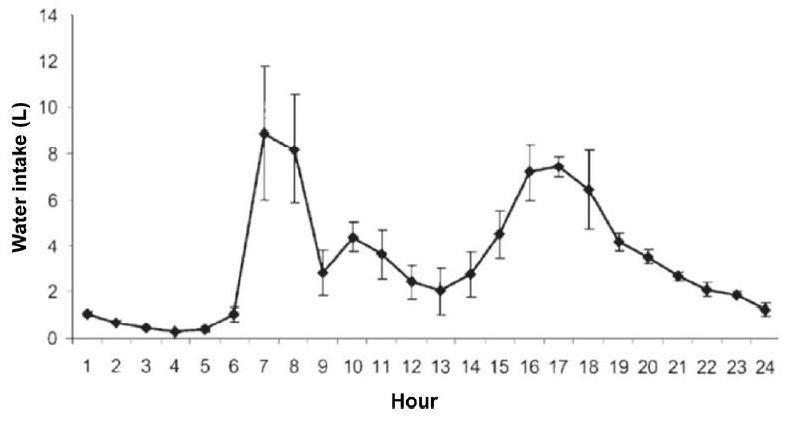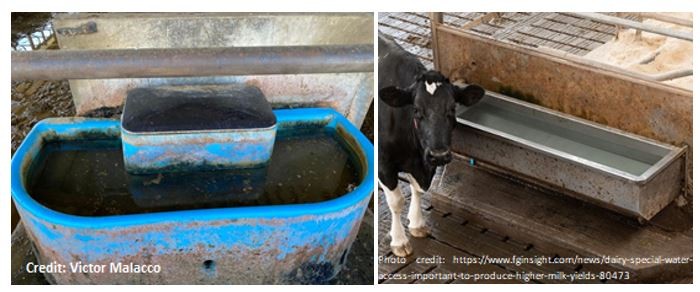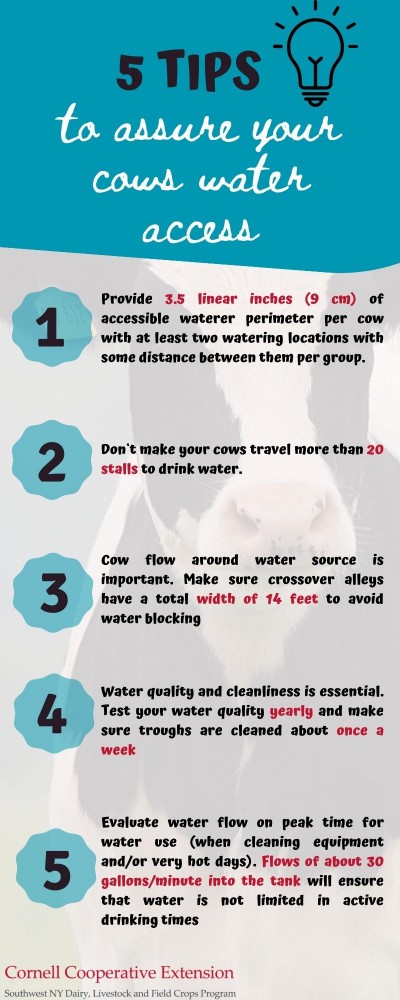Why is water essential? Rethinking your cow's water access
Camila Lage, Dairy Management Specialist
Southwest New York Dairy, Livestock and Field Crops Program
Why is water essential? Rethinking your cow's water access
By Camila Lage, Dairy Management Specialist
Did you know that half of Americans don't drink enough water? Despite our knowledge that water is crucial to keep our body functioning properly, our busy routines can get in the way of our hydration if we don't always have a full water bottle. The same is true for our dairy cows. With so many important things to deal with on a dairy farm, it is easy to overlook water resources when routinely evaluating farm management. I recently read a review on JDS that showed, based on reports on Welfare Quality scores across European countries, that although improved in recent years, there is still much room for improvement in access to fresh drinking water in dairy cattle production. The review also reflects on how little research is available on compensatory water intake in cows (drinking all needed water in limited visits) and how it may affect their stress levels, performance, and welfare.
How do cows drink water, and how much water do they need?
Water is a crucial nutrient for cattle. In addition to maintaining various physiological functions such as digestion, transportation of nutrients to cells, and regulation of body temperature, milk is about 87% water, which means that a dairy cow producing 60 pounds of milk a day will excrete 52 pounds of water/per day just by producing milk. The main water sources for our livestock are drinking water (which provides up to 80% of needs) and water contained in the feed. The main determinants of dairy cow water requirements are milk production, feed ration composition, and ambient and water temperatures. A Holstein cow drinks, on average, 2.7 lb/lb of milk produced daily, meaning that a cow producing 70 lbs of milk would need almost 24 gallons of water/per day. This can almost double at high temperatures, making water availability during summer critical.
The drinking behavior of dairy cows is closely related to their schedules of feeding and milking. Indoor-housed cows fed TMR diets and milked twice a day will drink roughly 40% of their water within two h of both feeding and milking. (Figure 1). A dairy cow will typically spend between 10 to 60 min/day drinking and will go to the water source approximately 5 to 20 times a day. It is important to remember that cows are social animals that tend to synchronize their behavior, which means competition will occur when there is limited access to a resource.

Figure 1. An example of how lactating cows drink water during a whole day. The time of milking was 0530 and 1630 h and the feeding times were 0700 and 1500, respectively (Osborne et al., 2020, modified by Jensen and Vestergaard, 2021).
Water quality
Water is a limited resource and ensuring good quality water for livestock animals is not always easy. However, providing low-quality water to your cows can reduce water intake and affect performance and health. A research project from Penn State analyzing water quality in 243 farms observed that almost 1/3 of farm water supplies had at least one water quality issue. Interestingly, average milk production for these farms was 10 pounds lower when compared with farms with good water quality. Also, none of the farms with high milk production (above 75 pounds of milk per cow per day) had water quality problems, while 32% of farms with low milk production (below 50 pounds of milk per cow) had at least one potential water quality problem.
- Water analysis: Good quality drinking water is clear, colorless, odorless, has low total solids, and does not contain pollutants or disease-causing organisms. Ideally, water testing should be done yearly. Many labs offer this service, and kit packages and instructions on collecting samples are available on lab websites. If you want more information on water analysis, please reach out at cd546@cornell.edu
- Evaluating herd water consumption: If you suspect water quality problems, evaluating the water intake of the herd can also be a valuable troubleshooting tool. In brief, this can be done by installing water meters on lines to drinking devices (when cows cannot access other water sources) over 5-10 days and comparing the average daily results of water intake to estimates of what they should be drinking. If you are interested in learning more about this tool, you can read it here.
Water cleanliness:
Even if the farm has high-quality water, dirty troughs/bowls, contaminated water, or a bad taste can reduce cows' water intake and/or negatively affect their production and health. An excellent way to know if the water is clean enough is often to ask yourself if you could drink the water. Of the two pictures below, which would you prefer to drink water from?

Water troughs should be cleaned about once a week. Empty the tank and scrub all the dirt, algae, and other residues the best you can. Rinse it with a 10 percent bleach solution and rinse it at least 2x more with regular water to clean any bleach residue. For bowls, especially cows in tie stalls, cleaning should be performed more often if bowls are accumulating feed and dirt.
Water access and flow:
Water quality and cleanliness are critical to ensure drinking motivation. However, lack of water availability will also affect water intake and limit herd performance. Good water access means that each cow has adequate space to drink water whenever she wants without competition and that enough water is always available. According to current recommendations, we should:
- Provide 3.5 linear inches (9 cm) of accessible waterer perimeter per cow with at least two watering locations with some distance between them per group. If using bowls, a minimum of 1 water bowl per 6 cows would be ideal.
- Study has shown that the water trough located in the middle of the barn is the heaviest used, which highlights the importance of cows not needing to travel more than 20 stalls to drink water.
- Cow flow around the waterer is very important, and the alley width should be a minimum of 12 feet for cow flow around the waterer, with the entire width of the crossover totaling 14 feet.
- Have a water supply rate of at least 6 to 7 gallons per minute. However, considering that the time right after milking is also a peak time for water use for cleaning the parlor and milking equipment, having water systems designed to provide about 30 gallons per minute flow rate into the tank will ensure that water does not become limited at active drinking times.
- The upper edge of the waterer should be located 24 to 32 inches (61 to 81 cm) above the cow standing surface for mature Holstein cows (21 to 29 inches (53 to 74 cm) for Jerseys). The water level should be within 2 to 4 inches (5 to 10 cm) of the upper edge.
References:
Appuhamy, J.A.D.R.N., Judy, J.V., Kebreab, E. and Kononoff, P.J., 2016. Prediction of drinking water intake by dairy cows. Journal of Dairy Science, 99(9), pp.7191-7205.
Becker, C. 2015. The value of water. Penn State University Extension Publication.
Grant, R. 2021. Never cut corners on water availability. Hoards Dairyman: The National Dairy Farm Magazine. April 25, 2021. Pp 140-141.
Jensen, M.B. and Vestergaard, M., 2021. Invited review: Freedom from thirst—Do dairy cows and calves have sufficient access to drinking water? Journal of Dairy Science, 104(11), pp.11368-11385.
Kononoff, P.J., Clark, K.J. 2017.Water Quality and Requirements for Dairy Cattle. Nebraska Extension.
Koronoff, P.J., Snow, D.D. and D.A. Christensen., 2017. Drinking water for dairy cattle. In. Large Dairy Herd Management, 3rd ed. Pp.611-624.
Swistock, B. 2015.Interpreting drinking water tests for dairy cows.Penn State University Extension Publication.
https://dairyone.com/services/forage-laboratory-services/water-analysis/

Upcoming Events
WEBINAR - Automated Milking Systems Efficiency: Balancing Focus on Individual Cows and System Optimization
May 8, 2024
Please join Cornell the SWNY team and MSU Extension for our talk with Dr. Pablo Silva Boloña on improving efficiency of Automated milking systems by focusing on milking settings for individual and group success.
Broiler Field Day at Sunny Cove Farm
June 6, 2024
Alfred Station, NY
Join us for a field day to explore broiler production, processing, and finances. Meghan Snyder of Sunny Cove Farm will be our host. She raises small batches of organic broilers, processing them on-farm under the 1,000 bird exemption.
Cornell Seed Growers Field Day
July 2, 2024
Ithaca, NY
Please Save the Date for the Cornell Seed Growers Field Day to be held the morning of July 2nd. The event will be held at the NYSIP Foundation Seed Barn, 791 Dryden Rd., Rt. 366, Ithaca, NY.
Announcements
No announcements at this time.





